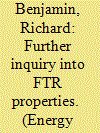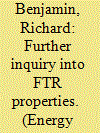| Srl | Item |
| 1 |
ID:
169721


|
|
|
|
|
| Summary/Abstract |
The use of uneconomic virtual transactions in day-ahead electricity markets with the intent to benefit related financial positions constitutes cross-product manipulation, and has emerged as a policy concern in recent years. Developing analytical frameworks and models to explain the means for achieving sustained day-ahead price manipulation is a challenge. This paper presents a two-stage equilibrium model of day-ahead price manipulation to enhance the value of financial transmission rights (FTRs). We cast the problem as a Stackelberg game between manipulating traders in the day-ahead market (leaders) and generating firms, grid operator and traders without FTRs in the day-ahead and real-time markets (followers). The model accounts for features specific to electricity systems, like intertemporal constraints of power generating units and real-time uncertainty, and considers imperfect competition as a condition allowing manipulation in equilibrium. We simulate hourly financial trading and operations decisions in a small test system for 24 hours. Results suggest that cross-product manipulation is sustained in equilibrium only when both physical and financial participants engage in Cournot competition. Further, as a result of loop flows, price separation between FTR source and sink may be induced by virtual transactions at network locations that are not on the FTR path.
|
|
|
|
|
|
|
|
|
|
|
|
|
|
|
|
| 2 |
ID:
096721


|
|
|
|
|
| Publication |
2010.
|
| Summary/Abstract |
William Hogan introduced financial transmission rights as a tool to hedge the locational risk inherent in locational marginal prices. FTRs are claimed to serve four main purposes: (1) provide a hedge for nodal price differences, (2) provide revenue sufficiency for contracts for differences, (3) distribute the merchandizing surplus an RTO accrues in market operations, and (4) provide a price signal for transmission and generation developers. This paper examines the hedging and redistributional properties of FTRs. It argues that FTR allocation has important distributional impacts and related implications for retail rates. This observation adds an additional explanation for rate increases in light of decreased production costs due to restructuring. This paper also shows that RTO practices have important implications for the hedging characteristics of FTRs. It further shows, via counterexample, that, even in theory, FTRs may not serve as a perfect hedge against congestion charges. The paper concludes with a series of recommendations for FTR allocation and the functions that FTRs should serve.
|
|
|
|
|
|
|
|
|
|
|
|
|
|
|
|
| 3 |
ID:
097514


|
|
|
|
|
| Publication |
2010.
|
| Summary/Abstract |
William Hogan introduced financial transmission rights as a tool to hedge the locational risk inherent in locational marginal prices. FTRs are claimed to serve four main purposes: (1) provide a hedge for nodal price differences, (2) provide revenue sufficiency for contracts for differences, (3) distribute the merchandizing surplus an RTO accrues in market operations, and (4) provide a price signal for transmission and generation developers. This paper examines the hedging and redistributional properties of FTRs. It argues that FTR allocation has important distributional impacts and related implications for retail rates. This observation adds an additional explanation for rate increases in light of decreased production costs due to restructuring. This paper also shows that RTO practices have important implications for the hedging characteristics of FTRs. It further shows, via counterexample, that, even in theory, FTRs may not serve as a perfect hedge against congestion charges. The paper concludes with a series of recommendations for FTR allocation and the functions that FTRs should serve.
|
|
|
|
|
|
|
|
|
|
|
|
|
|
|
|
| 4 |
ID:
093533


|
|
|
|
|
| Publication |
2010.
|
| Summary/Abstract |
Improvement and expansion of the transmission grid is still an unresolved issue in the new competitive environment. In current electricity markets, transmission lines have become assets that need financial instruments for investors who wish to ensure steady long-term returns and to withstand short-term market volatility. The timing and the combination of new transmission investments is key to analyze their long-term effects. This paper presents the concept of net present value (NPV) curve to estimate the best investment time for the investor, where the curve is constructed by calculating the NPVs resulting from the investment in successive years. A specific contract model based on financial transmission rights (FTR) is used for the NPV evaluation of transmission assets, and the stochastic properties of all variables related to the investment market structure are considered. The model is applied to the IEEE 24-bus Reliability Test System (RTS) showing the approach capabilities as a decision-aid tool for transmission investors.
|
|
|
|
|
|
|
|
|
|
|
|
|
|
|
|